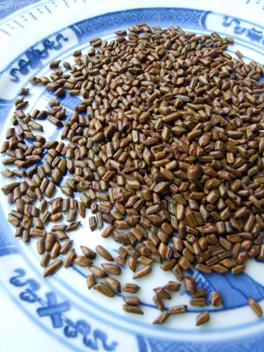|
 Cassia seed |
|
| Name |
Latin Name: Semen Cassiae
Common Name: Cassia seed
Scientific Name: Cassia obtusifolia L. / Cassia tora L.
Chinese Name: 決明子
Pinyin Name: jue ming zi |
| Top |
|
| Origin |
| Cassia seed is the ripe seed of the annual plant Cassia obtusifolia L., or Cassia tora L., of the Leguminosae family.[1] |
| Top |
|
| Where Does It Grow? |
| Cassia seed is widely cultivated in China, and mainly produced in provinces like Anhui, Guangxi, Sichuan, Zhejiang and Guangdong.[1],[5] |
| Top |
|
|
| Nature and Flavor |
| Cassia seed is sweet, bitter and salty in flavor, mild cold in nature, and mainly manifests its therapeutic actions in the liver and large intestine meridian.[1],[2] |
| Top |
|
| Identified Active Components / Major Chemical Constituents |
Cassia seed has complex components which mainly are anthraquinone compounds such as chrysophanol, physcion, emodin, aloeemodin, rhein, emodin monoglucoside, obtusin, aurantio-obtusin, obtusifolin, chrysophanol-9-anthrone, & chrysophanol-10,10'-bianthrone. Besides, it contains naphthalene derivatives such as cassiaside, cassiaside B-C, toralactone, isotoralactone, rubrofusarin, norrubrofusarin, rubrofusarin-6-O-gentiobioside; sterols such as cholesterol, stigmasterol and β-sitosterol; and organic ester compounds such as palmitic acid, stearic acid, oleic acid and linoleic acid. There are also vitamin A, reducing sugar, polysaccharides, proteins, amino acids and multiple minerals.[4],[6],[7]
In the Pharmacopoeia of People's Republic of China (2010 Edition) - Part I, the level of chrysophanol should not less than 0.20%, and the level of aurantio-obtusin should not less than 0.080%, as the standard qualities of cassia seed. |
| Top |
|
| Drug actions in TCM |
| Cassia seed clears liver heat, sharpens eye sight, lubricates intestines and promotes bowel movements.[2] |
| Top |
|
| Traditional Use in TCM |
Cassia seed is often used in conditions like painful and red eyes, teary eyes, eye sensitivity to light exposure, glaucoma, hypertension, headache, dizziness, dim or blurred vision, and constipation.[2],[3],[4],[5]
- Cassia seed clears heat and soothes liver
Hyperactive of liver yang leads to hypertension, headache and dizziness, cassia seed can work with white peony root, selfheal fruit spike, abalone shell, glossy privet fruit and and yerbadetajo herb for relief.
- Cassia seed is commonly used in eye problems
Cassia seed along with chrysanthemum, mulberry leaf, and feather cockscomb seed clear wind and heat in the head region, which can ease symptoms like red eyes, sensitive to light and glare, or teary eyes (e.g. in acute conjunctivitis); when the seed used along with Chinese gentian root, selfheal fruit spike, gardenia fruit, the remedy treats heat stagnation in the liver and gallbladder and can ease painful and red eyes too; the seed can work with belvedere fruit to improve night blindness; it can work with rehmannia root and wolfberry fruit to invigorate the liver and kidney, and thus relieve eye dryness, clouded, blurred or dim vision, that commonly seen in conditions like retinitis, optic atrophy and early stage cataract.
- Cassis seed soothes intestines and promotes bowel movements
Heat accumulated in the intestines leads to constipation, which is suitable to use cassia seed, either prepared as tea or decoction. Hamp seed and snakegourd seed can also be added in the remedy.
Fried cassis seed is commonly used in Chinese medicinal dishes for protecting liver, improving vision, lowering blood lipids and pressure.
|
| Top |
|
| Pharmacological Actions |
|
Studies showed that cassia seed have effects in anti-septic, immune inhibition, liver protection, improving vision, reducing blood lipids and pressure, inhibiting blood platelet clotting, promoting bowel movements, inducing urination and enhancing gastric secretion.[4],[7]
|
| Top |
| Toxicology |
| Animal studies have found that anthraquinone compounds contain in the medicinal plants are carcinogenicity, and hydroxy anthraquinone compounds such as emodin, dihydroxyanthraquinone and aloe-emodin may induce reproductive toxicity (e.g. poisonous to the testicle or bone marrow cells). However, the amount of these compounds in cassis seed are low, and thus the toxicity and carcinogenic effects of cassis seed need further study. For fried cassis seed, as the structure of anthraquinone compounds are damaged by high temperatures, their actions are diminished obviously.[4],[7] |
| Top |
|
| Administration and Dosage |
| For decoction, the usual dosage of cassia seed is 9∼15g; it can be higher to 30g if necessary. Cassia seed may also be ground to make pills or as powder for oral administration. Fried cassia seed 3g is used to prepare tea.[4] |
| Top |
|
| Adverse Effect, Side Effects and Cautions |
| Not indicated to those with diarrhea or a weak digestion. Fried cassia seed tea is a popular summer drink in China, and is rarely associated with any adverse reaction.[4] |
| Top |
| References |
| 1. |
Li Jiashi (editor-in-chief), Chinese Medicine Identification, Shanghai Scientific and Technical Publishers, 2000-2. |
|
|
| 2. |
Lui Daiquan (editor-in-chief), Chinese Herbal Medicine, Shanghai Scientific and Technical Publishers, 2000-6. |
|
|
| 3. |
Tao Yufeng, Clinical Herbal Medicine, People’s Medical Publishing House, 2005-5. |
|
|
| 4. |
Chen Pian, Clinical Application of Tonifying Herbs, Second Military Medical University Press, 2008-8. |
|
|
| 5. |
Nanjing University of Chinese Medicine (edited), Materia Medica, Shanghai Scientific and Technical Publishers, 2005-5. |
|
|
| 6. |
http://baike.baidu.com/subview/20881/5679215.htm |
|
|
| 7. |
http://www.zysj.com.cn/zhongyaocai/yaocai_j/juemingzi.html |
|
|
|
| Top |
|
|
|
|